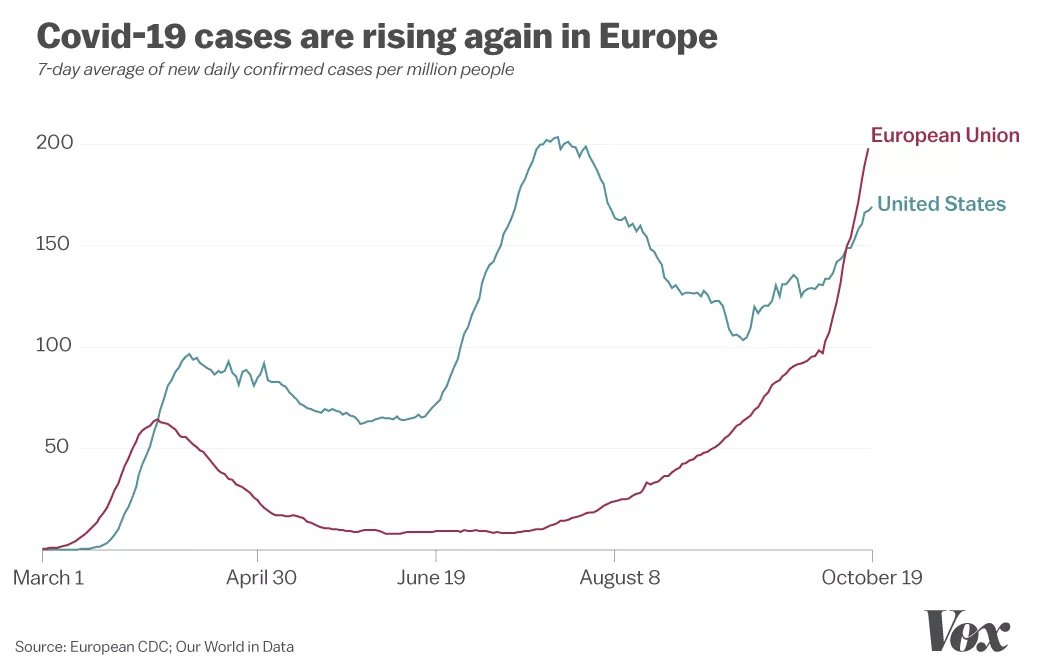
THREAD: I've been thinking about what causes the waves of COVID we've been seeing. A common explanation is weather or seasons. Eg, cold weather pushes ppl indoors in close contact. I want to explore another (economic) one: delayed reporting & prevalence response elasticity. 1/24 

TLDR: A possible economic explanation for COVID waves, esp hi frequency or quick waves, is a/ delayed info about cases & b/ collective action problems. This explanation is not mutually exclusive w the seasonal explanation. @toxvaerd1 @tylercowen @ATabarrok @arpitrage @nebuer42 2/
It has implications. For science, policy: Plot longer run (months-long) moving averages to see what's happening w COVID. This may affect parameter estimation for epi models. For econ research: take seriously policy endogeneity if using time series to estimate effect of policy. 3/
Background: Waves are not unique to COVID. Famously, there were 3 waves of the 1918 flu (below, cdc.gov/flu/pandemic-r…). 4/ 

But waves are common in other pandemics (table below, cebm.net/covid-19/covid…). 5/ 

Now let's explore causes. Cause #1: A common one (from epidemiology) is seasons (below). It's consistent w/ data given prior pandemics waves spanned years not months. It makes common sense: ppl huddle inside when it's cold outside, spreading infection. 6/
hopkinsmedicine.org/health/conditi…
hopkinsmedicine.org/health/conditi…
Of course, this plays out differently around the world. Eg, in Arizona, risk may peak during the summer when ppl come indoors for AC. In India, risk may peak during monsoons, when ppl come indoors to avoid rain. 7/
vox.com/2020/7/10/2131…
indianexpress.com/article/explai…
vox.com/2020/7/10/2131…
indianexpress.com/article/explai…
There may be other reasons why seasons affect infection other than crowding: eg, effect of temperature on viral particles, protective effects of sunlight/vitamin D, etc.
I do not dispute that seasons matter. I want to explore another, behavioral contributor. 8/
I do not dispute that seasons matter. I want to explore another, behavioral contributor. 8/
Cause #2: Delayed reporting & collective action problems. Let me explore these dynamics in turn. (Note, I;ve really folded 2 explanations into 1, but they stand independently as possible causes of relatively high frequncy waves.) 9/
a/ Delayed reporting: The intuition is the same as the problem of water temperature in a shower. If the water is too cold, you turn the temp knob up. But the heater responds w/ a delay. In the interim, you think you didn't turn the knob enuf. So you increase temp again. 10/
When the hot water finally gets to you, it's scalding. So then you turn the temp knob down. But you face the same problem on the way down. 11/
This happens with COVID. Cases are low to start. Society (govt + ppl) doesn't take it seriously, keeps up activity. Cases rise quickly. But delays in taking tests, getting test results, reporting results publicly mean society finds out with delay. 12/
Society engages in social distancing or suppression "too late". The negative effect on cases is immediate, but reporting is late. When it comes out, society relaxes, which raises cases. It relaxes for a while cuz it doesn't see cases except with a delay. The cycle repeats. 13/
b/ Collective action also contributes. Suppose there is no delay in getting COVID case counts. With collective action, even when I see cases rise, I may be slow to respond because I know you might curb activity protecting me, at cost to you but not to me. 14/
This can happen even with govt. Govt officials may wait thinking ppl will protect themselves. Ppl may wait thinking the govt will protect it. Again you get delay in action (even w/o delay in info). 15/
Policy: How do you solve this? a/ On delayed reporting: Get faster info on cases or base decisions on real-time "biomarkers" like mobility or google searches. It's not perfect cuz you have to know what mobility to "too high" or you wait for symptom searches. 16/
Plus there's error: biomarkers are convenient but imperfect measures. The errors themselves can create volatility in response. 17/
But any progress in reducing delay reduces amplitude of waves.
But any progress in reducing delay reduces amplitude of waves.
b/ Collective action, including by the govt. If you can solve this, we should just give you a Nobel prize right now. We have a list of other problems we'd like you to solve, e.g., climate change. ;) 18/
More srsly, this is a tough problem cuz even strict govt regulation is not sufficient. i/ It assumes harsh suppression is the right answer. It isn't always. ii/ Regulation is half the battle: enforcement is imperfect. That leaves room for individual variation in risk-taking. 19/
iii/ Regulation is hard to specify. Some activities are worth allowing even w rising cases (eg janitors at grocery stores). But it's hard to draw those lines well. Is it janitors at large grocers only, or also bodegas? 20.
Testing the theory: There's a way to test the delayed action explanation: test for waves in cases in locations w/ little seasonal variation in temps or crowding behavior. Think LA or San Diego. Or look for high frequency waves even w/in season in a place w seasons. 21/
For researchers: If the delay theory for waves has merit, there're ways that researchers can account it, whatever the cause. Eg, epi modelers could look at longer run moving averages of cases. Think of the waves of cases like fluctuations of stock prices around a price trend. 22/
If you fit that longer MA curve, you get different estimates of eg herd immunity threshold. W/o accounting for delays, you'd think you hit herd immunity w/ the first peak, and therein underestimate Rt, herd immunity, & implicitly beta/gamma. 23/
Help: I'm sure I'm not the first to point this out. If you read this and have references (even your own) let me know! 24/24 @satejsoman @sarahcobey @maciekboni @Noahpinion @EpiEllie @profmohanan @anuacharya @AnupamBJena @JustinWolfers @jonathangruber1 @skominers
• • •
Missing some Tweet in this thread? You can try to
force a refresh






